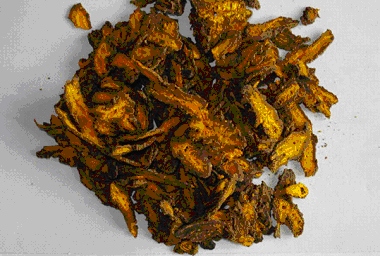Antibacterial-especially useful in bacterial dysentery, diptheria, Lung infections
and meningitis,[4] antiviral,[4]
antihypertensive.[4] Antipyretic.[4]
- High fever, irritability, dry mouth and
throat, and dark urine due to Fire toxin the the Three Burners, with
Scutellaria
baicalensis- Huang qin and
Gardinia
jasminoides- Zhi zi.
[5]
- Insomnia and delirium due to unremitting Heat injuring the nutritive level,
with
Rehmannia glutinosa- Sheng di huang.
Also for wasting and thirsting disorder (diabetes) due to excessive Heat, often
with addition of
Trichosanthes
kirilowii- Tian hua fen.
[5]
- Hot dysenteric disorders, with
Aucklandia
lappa- Mu xiang.
[5]
- Epigastric and abdominal pain, acid regurgitation, and epigastric upset due
to Liver Fire or Stomach Heat, with
Evodia
rutaecarpa- Wu zhu yu. For dysenteric disorder and abdominal pain, add
Paeonia
lactiflora- Bai shao.
[5]
- Insomnia due to a lack of communication between the Heart and Kidneys, with
Cinnamomum cassia- Rou gui.
[5]
- Toothache, swelling of the gums, and ulceration of the tongue and mouth caused
by Stomach Fire, with
Asarum heterotropoides-
Xi xin. Often used together with
Calcium sulphate-
Shi gao.
[5]
CONTRAINDICATIONS: Yin deficiency, nausea or vomiting due to
Stomach Cold from deficiency, and diarrhea due to Spleen and Kidney deficiency.
[5]
Long term use is discouraged as it can injure the Spleen and Stomach.
[5]
According to some traditional sources, this herb antagonizes
Chrysanthemum
morifolium- Ju hua,
Scrophularia
ningpoensis- Xuan shen,
Dictamnus dasycarpus-
Bai xian pi, and Jiang can, and counteracts
Tussilago
farfara- Kuan dong hua and
Achyranthes
bidentata- Niu xi. Some also say that it should not be taken with
Pork.
TOXICITY: Both Huang lian and berberine are relatively safe
with few side effects and no adverse effects from long term administration.
Up to 2 g of berberine or 100 g or Huang lian powder have been taken at one
time with no side effects.
[5]
PREPARATIONS: Decoction
Dry rhizome 2-10 g.[2,3,4,5] Dry
fry to attentuate its Cold properties and to help it enter the Blood.
[5]
Ginger juice fry, to treat Stomach Heat and stop vomiting.
Evodia
fry- Yu Huang lian, to treat Damp Heat in the Qi level with such symptoms as
diarrhea, vomiting, or belching.
[5]
Good quality is thick, strong, and solid with many interconnections. The cross
section of the rhizome from
C. chinensis should be a reddish yellow;
that from
C. deltoidea should be yellow.
[1] Barefoot Doctor's Manual- 1977 Prepared
by the Revolutionary Health Committee of Hunan Province. Original Chinese manual-
Victor W. Sidel. Originally published by Dr Joseph Quin and the Fogarty International
centre, Bethdesda (1974). Madrona Publishers Seattle Washington ISBN 0-914842-52-8
[2] A Complete English Dictionary of Medicinal Terms in Chinese Acupuncture
and Herbalism 1981- Henry Lu Chinese Foundations of Natural Health- The Academy
of Oriental Heritage, Vancouver, Canada.
[3] The Chinese Materia Medica A practical English- Chinese Library of Traditional
Chinese Medicine Publishing House of Shanghai University of Traditional Chinese
Medicine. Director Hu Ximing ISBN 7-81010-111-X/R-110.
[4] Translation notes from Gary Seiford and Hocu Huhn- NSW College of Natural
Therapies. Sydney Australia (1982).
[5] Chinese Herbal Medicine Materia Medica- Dan Bensky and Andrew Gamble- Eastland
Press 1986 Seattle Washington ISBN 0-939616-15-7
Images
1.
pureinsight.org
2.
naturallineus.com
3.
tcmwiki.com
4.
classicalpearls.org Berberine, coptisine, worenine, palmatine,
columbamine, obacunone, obaculactone, palmatine, jatrorrhizine, magnoflorine,
ferulic acid.[1]
References
[1] Chinese Herbal Medicine Materia Medica- Dan Bensky and Andrew Gamble- Eastland
Press 1986 Seattle Washington ISBN 0-939616-15-7
 Coptis
chinensis.
黄
连 Huáng
lián
Coptis
Coptis
chinensis.
黄
连 Huáng
lián
Coptis


